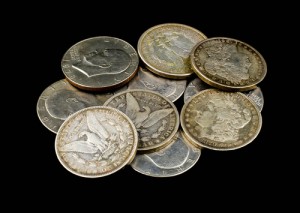Collecting old, valuable coins as a hobby has been a favorite pastime for hundreds of years. While collecting coins is an enjoyable and interesting hobby, did you know you can also invest in and reap tremendous profits from investment-grade coins?
The most ever spent on a coin was $10,016,875 on the 1794 Flowing Hair Dollar, sold at an auction in New York City in January 2013. A penny from 1792 (known as the “Birch Cent”) was bought by a Beverly Hills collector for $2,585,000 earlier this year. These record-breaking sales are drawing attention to coins as both an investment and collectible, but although coins are hot, there are a few things to remember to avoid possible costly mistakes.
According to the Federal Trade Commission, buying collectible coins as an investment takes not only patience but research. Before purchasing any coins the investor should be educated enough to understand the value of the coins. Collectible coins have what is called, “numismatic value” that is determined “…by factors like the type of coin, the year it was minted, the place it was minted, and its condition – or grade,” states the FTC.
Collectible coins are a long-term investment and most coins take at least ten years to rise in enough value to generate a profit. The FTC explains: “…dealers usually sell collectible coins at a markup…In addition, the market for numismatic coins may not be the same as the market for precious metals or bullion coins.”
There are several preliminary steps that should be taken by anyone who is seeking to invest in collectible coins such as bullion and byzantine coins – here are six tips you should know before turning a coin collection into profit:
- Understand the melt value of the coin – which is the true value of the coin or bullion if it was melted. Unscrupulous sellers will often inflate the price so understanding its melt value is paramount.
- Understand the investment value of the coin – According to Anthony Allen Anderson, Director of Sales Operations with Culver City-based Gold Silver Group, “most Gold and Silver owners are ill informed when it comes to the true premium value of their metals. Particulars like mintage, condition and completeness of holdings, (i.e. sealed monster boxes and rolls), can greatly increase value in investors favor.” Anderson is an associate member of the ICTA, a life member with the American Numismatic Association (ANA), and certified as a dealer with PCGS, CCE, Fiztrade and NGC and a leading expert on coin and precious metal investing.
- Keep in mind that dealers and brokers will raise the price of coin. Get a Coin Collection Quote through authorized dealers, websites and other means of information. Even eBay is an active market with sufficient liquidity and transparency to be a resource for determining value.
- Always examine coins in person or request a clear photo! If for some reason you cannot physically examine the coin, ensure you can see a photograph.
- Learn about the return policy. Most reputable dealers will offer you 14 days to return the coins if you are not satisfied. In addition, you can also inquire about a dealer’s buy back policy.
- You should understand the tax implications of your collectible coin investment Income from the sale of collectibles may be taxed at a higher rate than other investments. Visit irs.gov to better understand the tax rules for collectible coins or bullion.








